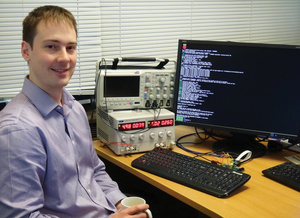Compute Module
We talk with James Adams about the new Raspberry Pi Compute Module.

We talk with James Adams about the new Raspberry Pi Compute Module.
On April 7, the Raspberry Pi Foundation announced an exciting new product. The Raspberry Pi Compute Module brings the Pi to a new professional audience – and it might even offer some new hacking opportunities for amateur Rasp Pi users. We asked Raspberry Pi's "Director of Hardware, Demon Welder, and Brewer of Beer" James Adams why the Compute Module is important and what it means for the open hardware community.
Raspberry Pi Geek: The Compute Module sounds like an exciting development for the Raspberry Pi community. Could you describe what it is and how it's different from an ordinary Pi?
James Adams: Basically, the Compute Module is the guts of a Raspberry Pi (the BCM2835 processor and RAM) plus 4GB of Flash on a small 67.6x30mm circuit board that fits into a standard DDR2 SODIMM socket (note the pinout is completely different from that used for actual DDR2 SODIMM modules!).
[...]
Pages: 4
Price $15.99
(incl. VAT)